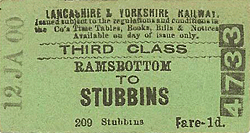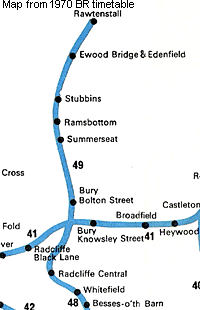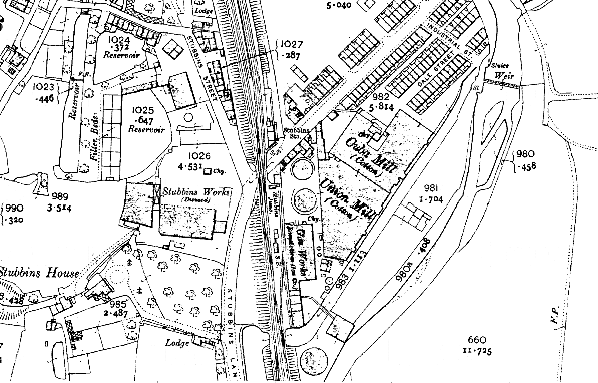Notes: Stubbins station was officially opened in January 1847. It was situated on the East Lancashire Railway company’s (ELR) Clifton Junction to Rawtenstall line which had opened to public services on 28th September 1846.
The idea for a line between Clifton Junction and Rawtenstall via Bury dated back to a meeting on 24th September 1843, the result of which was the creation of a company called the Manchester, Bury & Rossendale Railway (MB&RR) which was formally incorporated on 4th July 1844. Whilst the line was under construction the MB&RR amalgamated with the Blackburn, Bury, Accrington & Colne Extension Railway, and the new concern became the East Lancashire Railway on 21st July 1845.
 |
At its opening the line through Stubbins was double track, and so the station was provided with two platforms high up an embankment. A bridge took Bolton Road North under the line to the south of the station site, and a booking office was provided at road level on the north side of the road, east of the line. The stone building had two storeys at road level, the upper |
storey being at platform level. Steps led up to the platform at the southern end of the building.
At the time of opening five passenger trains ran on weekdays in each direction between Manchester and Rawtenstall; four trains ran on Sundays.
On 17th August 1848 the line through Stubbins became part of a secondary branch as from that date the ELR opened a line which started from a Stubbins Junction, immediately south of the station, and ran northwards to Accrington. This created a main line from Clifton Junction to Accrington, but no platforms were provided on it at Stubbins. In effect the main line ran to the west of the station which required the northbound platform to be quite narrow and also shorter than the southbound platform. A subway at the north end of the platforms linked them. The northbound platform had a fence at its rear to protect passengers from trains passing by on the main line. South of the station, on the east side of the line, a signal box was provided to control the junction.
In March 1848 the Stubbins to Rawtenstall line was extended northwards from Rawtenstall to Waterfoot, and four years later, from the 1st of October1852, to Bacup. On 13th May 1859 Stubbins station became part of the Lancashire & Yorkshire Railway (LYR) when the company absorbed the ELR.
 |
During the early years of LYR ownership passenger train services at Stubbins continued to run to Manchester via Clifton Junction.
The station never handled goods traffic although there was a private siding serving the Ramsbottom Gas Company; this closed in 1958. There was also an area of marshalling yards known as the Ramsbottom Sidings between Stubbins and Ramsbottom.
From 1st September 1879 Stubbins’ up (towards Manchester) passenger services followed a different route south of Bury. They no longer travelled via Clifton Junction and travelled on a new line via Prestwich instead.
In 1914 the LYR started a Railmotor service between Ramsbottom and Bacup serving all local stations including Stubbins. This supplemented trains that ran through to Manchester. The service was nicknamed ‘Little Billie’. From 11th April 1916 through passenger services to Manchester were diverted to follow yet another route, via Heywood, which added a considerable mileage to their journeys. The reason for the change was that from this date electric train services had been introduced on the Bury to Manchester, via Prestwich line. Passengers travelling to Manchester from Stubbins were encouraged to change onto the electric trains at Bury for a quicker onward journey, and most of them did so. Within a few years many southbound services were terminating at Bury Bolton Street. |
| On 1st January 1923 Stubbins became part of the London Midland & Scottish Railway (LMS). By the Summer of 1932 the station had twenty weekday trains travelling northbound to Bacup. The first service going northbound, which had originated from Bury Bolton Street, left at 6:08am. A terminating service had arrived from Bury Bolton Street a little earlier at 5:45 |
 |
The last service which had originated from Bury Bolton Street left Stubbins for Bacup at 11:31pm. Only four of the twenty trains had originated from Manchester Victoria. Most had started at Bury Bolton Street; one train had commenced its journey from Bury Knowsley Street and one from Bolton. Some services had started from Ramsbottom.
In the southbound direction there were twenty- three weekday departures, the first being a train for Middleton Junction at 5:41 am. The last train was for Bury Bolton Street and it left Stubbins at 11:36 pm. The rest of the services tended to travel to either Manchester Victoria or Bury Bolton Street, but there were trains at 9:21am, 10:41am and 3:16pm which went to Bury Knowsley Street, as well as shorter workings to Ramsbottom..
On 1st January 1948 Stubbins station became part of the nationalised British Railways’ London Midland Region. In 1954 the line between Bury and Bacup was considered to be busy enough to warrant the introduction of modern rolling stock, and it was reported in the local press that new Diesel Multiple Units (DMUs) were to be introduced. The DMUs were brought into service on the line in February 1956. Stubbins had thirty-five trains in each direction giving a half hourly service. It was to be the most intensive service that the line would see.

|
The purpose of Reshaping of British Railways (Beeching Report) of March 1963 was to create an economically viable network, involving the closure of many loss-making passenger lines and stations. The report’s proposals for Lancashire and north Manchester were astonishing. The entire route from Manchester via Bury Bolton Street to Bacup and |
Accrington was earmarked for closure, yet the nearby Manchester – Oldham – Rochdale and the Bolton – Bury Knowsley Street – Rochdale lines were not. The absurdity of withdrawing passenger services on the heavily used, electrified service between Manchester and Bury was acknowledged when, on 8th February 1965, the Minister of Transport refused consent to closure. However on 14th September 1966 the Minister gave permission for the Rawtenstall to Bacup and Bury to Accrington lines to close, which they did on 5th December 1966. (The final passenger train left Bacup on Saturday 3rd December). Stubbins ceased to be a working junction and the signal box that controlled it was taken out of use at this date, but it was not officially closed until 17th April 1968 when the line through Stubbins became a single track branch.
 |
From 5th December 1966 northbound trains from Stubbins terminated at Rawtenstall. The service became a shuttle between Bury Bolton Street and Rawtenstall, and from 4th March 1968 all stations north of Bury became unmanned. The March 1967 timetable showed fifteen services in each direction at irregular intervals, and two extra workings on Saturdays, one in the early afternoon and another late at night. No trains ran on Sundays. In the final year’s timetable from May 1971 weekday services had been reduced to twelve in each direction, with thirteen on Saturdays, the late night Saturday working having ceased by May 1970.
On 19th April 1970 the southbound line through the station was lifted, and the former northbound platform became bi-directional. A bus shelter was erected at the north end of the platform and about half of the length of the platform, at the south end, was fenced off as it was not required for trains of
|
only two coaches which became the norm. Interestingly despite it being closed a single track from the Accrington line was left in situ and provided with a set of points to connect it to the Bacup line on the site of the original junction.
On 5th June 1972 the service was withdrawn, and Stubbins station closed completely. The buildings were demolished but the platforms remained in situ. The Accrington line was lifted around this time. Freight trains serving a coal depot at Rawtenstall continued to pass through the Stubbins station site
until 1980. To mark the end of the coal trains a railtour called the Rossendale Flyer that ran from Bolton to Rawtenstall and then back again passed through Stubbins Station. Many local people came down to Stubbins station to see it pass by. After it had departed southwards the line was officially closed.
A preservation group called the East Lancashire Railway (ELR) after the original company entered into negotiations with British Rail with a view to re-opening the line from Bury to Rawtenstall. On 28th March 1982 they ran a Railtour called the Rossendale Phoenix which also passed through Stubbins station. After it had departed southwards the line was officially closed.
Supported by the local authorities the new ELR were successful and opened the stretch of line from Bury to Ramsbottom on 25th July 1987. On 27th April 1991 they opened the section of line to Rawtenstall. Consideration was given in the late 1980s to re-opening Stubbins Station and the former northbound platform was even extended at its southern end, across the site of the former Stubbins Junction. However the plans for re-opening Stubbins were dropped. Its platforms remain in situ and ELR train services pass through
Tickets from Michael Stewart , route map drawn by Alan Young, timetables from Alan Young
Click here to see of film of a train journey between Bury and Bacup in 1966
See also the Ramsbottom Model Railway Club web site which features 106 old photographs of the East Lancashire Railway and photographs of the clubs excellent layout of Ramsbottom & Stubbins.
Sources:
To see other stations on the East Lancashire Railway Clifton Junction - Bacup line click on the station name on the station name: Clifton Junction, Molyneux Brow, Ringley Road, Radcliffe Bridge, Withens Lane, Bury Bolton Street, Summerseat, Ramsbottom, Irwell Vale (new station on the ELR), Ewood Bridge & Edenfield, Rawtenstall, Clough Fold, Waterfoot for Newchurch, Stacksteads & Bacup
See also Stubbins Junction to Accrington:
Helmshore, Haslingden, Baxenden & Accrington |

old1.jpg)


old2.jpg)
old5.jpg)
old3.jpg)
11.jpg)
old6.jpg)
1.jpg)
17.jpg)
10.jpg)



.gif)



old_thumb7.jpg)
old_thumb4.jpg)
thumb15.jpg)
thumb16.jpg)
thumb2.jpg)
thumb3.jpg)
thumb23.jpg)
thumb12.jpg)
thumb4.jpg)
thumb17.jpg)
thumb18.jpg)
thumb19.jpg)
thumb20.jpg)
thumb21.jpg)
thumb22.jpg)
thumb24.jpg)

 Home Page
Home Page